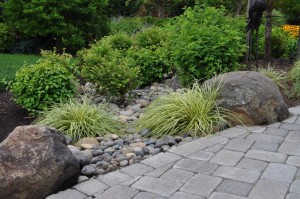Landscape Design and Rain Gardens
Northwest h ome owners with green thumbs can rattle off a long list of different types of gardens they may have in their yard as part of their landscaping design. There are vegetable gardens, herb gardens, flower gardens, and many more. But there is one type of garden that not every home owner is aware of – the rain garden.
ome owners with green thumbs can rattle off a long list of different types of gardens they may have in their yard as part of their landscaping design. There are vegetable gardens, herb gardens, flower gardens, and many more. But there is one type of garden that not every home owner is aware of – the rain garden.
What are rain gardens?
A rain garden is a planted depression that catches and absorbs rain water that runs off your roof, sidewalk, driveway, porch, or other hard area around your house. Only native plants should go into a rain garden design – landscape with native plants work the best at absorbing excess water and are tolerant of the local climate. Once the rain water has absorbed into the garden it slowly filters into the ground, reducing the amount of storm water runoff in your area.
Why are rain gardens important?
Storm water runoff is a big problem in many urban areas. Since the water can’t be absorbed by buildings or concrete it has nowhere to go but into the drain, collecting pollution along the way. Including a rain garden in your Lake Oswego landscaping design is a great way to reduce the amount of polluted rainwater that ends up in your rivers and groundwater.
Where did rain gardens come from?
Residential rain gardens were first developed in Maryland in the early 1990s. The first rain gardens were part of low impact development design for landscape and were generally installed on larger scales, like in subdivisions. More recently, home owners have recognized the relative ease in which they can include a rain garden as part of their own landscaping services.
What are the benefits of a rain garden?
According to a report from the Environmental Protection Agency, almost 70% of all the pollution found in America’s surface waters comes from storm water runoff. As rain water flows to the drains, it picks up road salt, animal waste, garbage, yard pesticides and fertilizers, and many more known pollutants. Reducing storm water runoff by installing a rain garden drastically cuts down on the amount of pollution that ends up in our lakes, rivers, and streams.
Including a rain garden in your landscaping design also helps keep your yard clean and attractive. Rain gardens reduce the amount of standing water in your yard, ensure a healthier lawn, reduce the amount of mosquito breeding that goes on, and helps you conserve water.
How do I install a rain garden?
Rain gardens are not exactly a DIY operation. There is a lot involved in getting a functional rain garden in the ground. While you should definitely call a landscaping services professional before beginning the project, you should also know just what is involved in including a rain garden in a landscaping design. The following are the basic steps to installing a rain garden.
1. Observe and map your yard.
In this step you will determine how water flows around your property so that you can place the rain garden in the most beneficial place. Walk through your yard, taking note of slopes, hills, or depressions.
2. Determine placement.
Based on the information you gathered in the previous step, decide where to put your garden. A common choice is right next to a downspout, but if you have a valley in your yard that regularly collects water that might also be a good spot.
3. Assess the quality of your soil.
This step involves digging a hole to test the water drainage. It is also best left to a professional. The drainage rate will determine the type of rain garden that should be included in your landscaping designs.
4. Choose the size of your garden.
Rain gardens are usually between 6 to 24 inches deep. Of course, only a landscaping services professional can determine what size of rain garden is appropriate for your yard.
5. Build it!
Again, this step should be left to your chosen Lake Oswego landscaping services company. It involves digging the bed, adding special amended soil, planting a variety of native plants, and allowing for water overflow. It also often means creating a rock-lined trench to carry water from downspouts to the garden.
6. Regular maintenance.
This step is definitely something you can handle on your own. It mainly involves pulling weeds, mulching, and pruning. Most home owners with rain gardens work the garden maintenance into their regular gardening schedule.
Although a relatively new addition to landscape designs, rain gardens are gaining popularity due to their many benefits and natural beauty. If you think your yard could benefit from a rain garden talk to a landscaping professional today.
